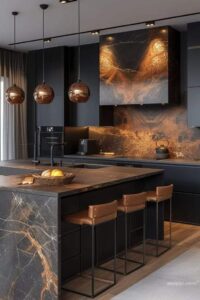Causes of Rust in Stainless Steel Modular Kitchens

Stainless steel is revered for its durability, resistance to corrosion, and sleek appearance, making it a preferred choice for modular kitchen designs. However, despite its name, stainless steel is not entirely impervious to rust. When unsightly rust spots begin to mar the pristine surfaces of your stainless steel modular kitchen, it can be perplexing and frustrating. In this comprehensive guide, we will delve into the various causes of rust in stainless steel kitchens and explore preventive measures to keep your kitchen looking flawless. At Karvi Interio, we believe in empowering homeowners with the knowledge to maintain their kitchen investments.
Causes of Rust in Stainless Steel Modular Kitchens
Understanding the Composition of Stainless Steel
Stainless steel is an alloy composed primarily of iron, with varying amounts of chromium, nickel, and other elements. The addition of chromium enhances the steel’s corrosion resistance by forming a protective oxide layer on the surface. However, certain factors can compromise this oxide layer, leading to rust formation.
Common Causes of Rust in Stainless Steel Modular Kitchens
A. Exposure to Chlorides
Chlorides, such as those found in salt, seawater, and cleaning products, can penetrate the protective oxide layer of stainless steel, leading to pitting corrosion and rust formation. Areas near coastal regions or swimming pools are particularly susceptible to chloride exposure.
B. Harsh Cleaning Chemicals
Abrasive or acidic cleaning agents can strip away the protective oxide layer of stainless steel, leaving it vulnerable to rust. Avoid using harsh chemicals such as bleach, ammonia, or chlorine-based cleaners, and opt for mild, pH-neutral cleaners specifically formulated for stainless steel.
C. Iron Contamination
Contamination from iron particles, often introduced during manufacturing or fabrication processes, can compromise the corrosion resistance of stainless steel. This is especially common in poorly maintained fabrication equipment or when stainless steel comes into contact with carbon steel or iron-rich materials.
D. Scratch and Abrasion
Scratches, abrasions, or gouges on the surface of stainless steel can provide entry points for moisture and corrosive agents, accelerating rust formation. Avoid using abrasive materials or harsh scrubbers when cleaning stainless steel surfaces, and promptly address any scratches to prevent further damage.
E. Stagnant Water
Stagnant water or moisture accumulation in crevices, seams, or around sink areas can create localized corrosion and facilitate rust formation. Proper ventilation, drainage, and regular cleaning are essential to prevent water from pooling in these areas.
Preventive Measures to Combat Rust in Stainless Steel Kitchens
A. Regular Cleaning and Maintenance
Maintaining a regular cleaning routine is crucial for preserving the integrity of stainless steel surfaces. Clean surfaces with a mild detergent and warm water, followed by a thorough rinse and drying with a soft cloth to prevent water spots and streaks.
B. Use Stainless Steel-Safe Cleaners
Choose cleaning products specifically formulated for stainless steel to avoid damaging the protective oxide layer. Look for non-abrasive, pH-neutral cleaners that are gentle on stainless steel surfaces and free from harsh chemicals.
C. Avoid Abrasive Materials
Avoid using abrasive materials such as steel wool, wire brushes, or abrasive sponges, as they can scratch and damage stainless steel surfaces. Instead, opt for soft cloths, microfiber towels, or nylon scrub brushes for gentle cleaning.
D. Address Scratches Promptly
Address any scratches, gouges, or abrasions on stainless steel surfaces promptly to prevent rust formation. Use a stainless steel polish or restoration product to buff out minor scratches and restore the surface’s protective layer.
E. Ensure Proper Ventilation and Drainage
Ensure adequate ventilation and drainage in your kitchen to prevent moisture accumulation and stagnant water. Regularly inspect sink areas, faucet joints, and seams for signs of leaks or water buildup, and promptly address any issues.
Advanced Solutions for Rust Prevention
A. Passivation Treatment
Passivation is a chemical process that removes contaminants and enhances the corrosion resistance of stainless steel surfaces. This treatment forms a protective oxide layer, preventing rust formation and extending the lifespan of stainless steel components.
B. Protective Coatings
Applying a protective coating or sealant to stainless steel surfaces can provide an additional layer of protection against corrosion and rust. These coatings create a barrier that shields the stainless steel from environmental factors and prolongs its durability.
C. Professional Inspection and Maintenance
Schedule regular inspections and maintenance checks with a professional to ensure the optimal performance and longevity of your stainless steel modular kitchen. Professionals can identify potential issues early on and implement preventive measures to mitigate corrosion and rust.
Real-Life Examples: Case Studies in Rust Prevention
Example 1: Coastal Kitchen Retreat
A coastal kitchen retreat features stainless steel modular cabinets and countertops, providing durability and resistance to saltwater exposure. Regular passivation treatments and diligent maintenance help preserve the stainless steel surfaces, ensuring they remain rust-free and pristine despite the harsh coastal environment.
Example 2: Urban Loft Kitchen
An urban loft kitchen showcases sleek stainless steel appliances and fixtures, complemented by minimalist design elements. The use of stainless steel-safe cleaners and protective coatings maintains the integrity of the stainless steel surfaces, preventing rust and corrosion in the bustling urban environment.
Example 3: Rustic Farmhouse Kitchen
A rustic farmhouse kitchen combines stainless steel countertops with reclaimed wood accents, creating a charming and functional space. Regular inspections and maintenance checks by professionals ensure that the stainless steel surfaces remain in optimal condition, even in the rugged farmhouse setting.
Conclusion: Safeguarding Your Stainless Steel Investment
While stainless steel is renowned for its durability and resistance to corrosion, it is not immune to rust when exposed to certain environmental factors or harsh cleaning practices. By understanding the common causes of rust in stainless steel kitchens and implementing preventive measures, you can safeguard your stainless steel investment and enjoy a beautiful, rust-free kitchen for years to come.
At Karvi Interio, we are committed to providing homeowners with the knowledge and resources to maintain their stainless steel modular kitchens. Whether you’re seeking advanced solutions for rust prevention or simple maintenance tips, we’re here to help you keep your kitchen looking flawless. Contact us today to learn more about our stainless steel kitchen solutions and how we can assist you in preserving the beauty and functionality of your kitchen.
Ready to explore a Basic Range of Wood, an Affordable range of galvanized steel and Premium stainless steel kitchen cabinets in Bangalore, kitchen interior & wardrobe solutions for your space? with different combination shutters complete home interiors in steel with Stainless Steel PVD Furniture Contact Karvi Interio today for personalized consultations and expert design services. Visit our website to discover the efficiency and durability of stainless steel wardrobes tailored to your needs. Construction for interior products Gauge, visit our YouTube channel for information videos, Before visiting the showroom some of the steps to follow, Looking for Collaboration with US, About warranty & guarantee, Transform your storage spaces with Karvi Interio’s expertise!

